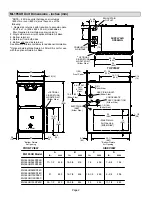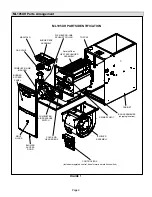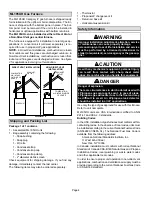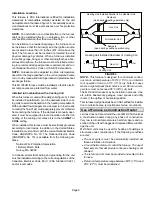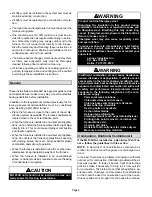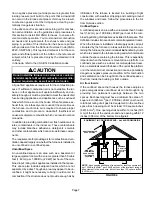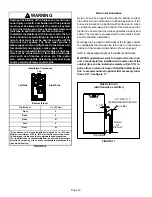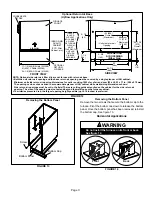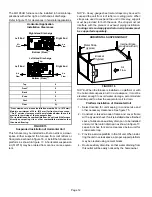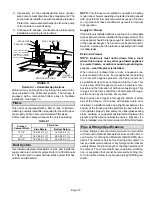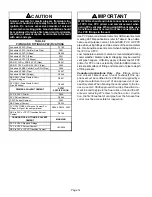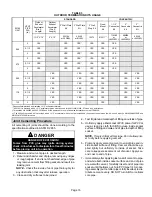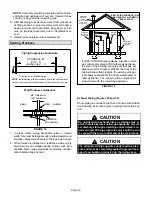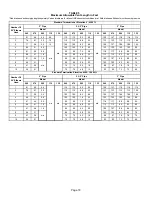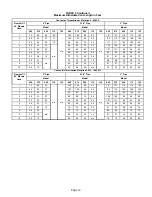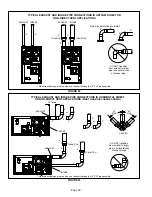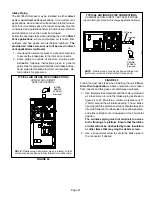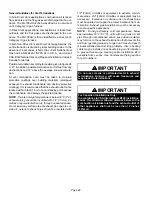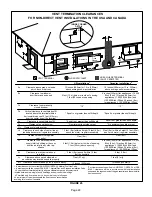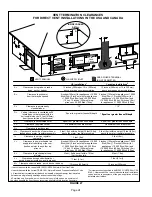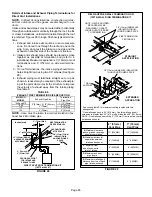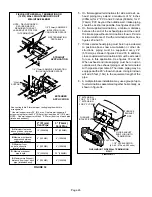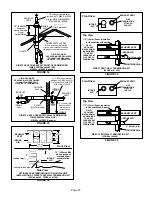
Page 13
5 − If necessary, run the condensate line into a conden-
sate pump to meet drain line slope requirements. The
pump must be rated for use with condensing furnaces.
Protect the condensate discharge line from the pump
to the outside to avoid freezing.
6 − Continue with exhaust, condensate and intake piping
installation according to instructions.
FIGURE 17
*Gas connector may be
used for Canadian
installation if accept-
able by local authority
having jurisdiction.
*GAS CONNECTION
RAISED
PLATFORM
SERVICE PLATFORM
INTAKE PIPE
EXHAUST PIPE
Return Air −− Horizontal Applications
Return air may be brought in only through the end of a fur-
nace installed in the horizontal position. The furnace is
equipped with a removable bottom panel to facilitate
installation. See figure 13.
Filters
This unit is not equipped with a filter or rack. A field−pro-
vided high velocity rated filter is required for the unit to oper-
ate properly. Table 1 lists recommended filter sizes.
A filter must be in place whenever the unit is operating.
TABLE 1
Furnace
Cabinet Width
Filter Size
Side Return
Bottom Return
17−1/2"
16 X 25 X 1 (1)
16 X 25 X 1 (1)
21"
16 X 25 X 1 (1)
20 X 25 X 1 (1)
24−1/2"
16 X 25 X 1 (2)
24 X 25 X 1 (1)
Duct System
Use industry-approved standards to size and install the
supply and return air duct system. Refer to ACCA Manual
D. This will result in a quiet and low-static system that has
uniform air distribution.
NOTE
− This furnace is not certified for operation in heating
mode (indoor blower operating at selected heating speed)
with an external static pressure which exceeds 0.8 inches
w.c. Operation at these conditions may result in improper
limit operation.
Supply Air Plenum
If the furnace is installed without a cooling coil, a removable
access panel should be installed in the supply air duct. The
access panel should be large enough to permit inspection
of the heat exchanger. The furnace access panel must al-
ways be in place when the furnace is operating and it must
not allow leaks.
Return Air Plenum
NOTE −
Return air must not be drawn from a room
where this furnace, or any other gas−fueled appliance
(i.e., water heater), or carbon monoxide−producing de-
vice (i.e., wood fireplace) is installed.
When return air is drawn from a room, a negative pres-
sure is created in the room. If a gas appliance is operating
in a room with negative pressure, the flue products can
be pulled back down the vent pipe and into the room. This
reverse flow of the flue gas may result in incomplete com-
bustion and the formation of carbon monoxide gas. This
raw gas or toxic fumes might then be distributed through-
out the house by the furnace duct system.
Return air can be brought in through the bottom or either
side of the furnace. If a furnace with bottom return air is
installed on a platform, make an airtight seal between the
bottom of the furnace and the platform to ensure that the
unit operates properly and safely. Use fiberglass sealing
strips, caulking, or equivalent sealing method between the
plenum and the furnace cabinet to ensure a tight seal. If a
filter is installed, size the return air duct to fit the filter frame.
Pipe & Fittings Specifications
All pipe, fittings, primer and solvent cement must conform
with American National Standard Institute and the Ameri-
can Society for Testing and Materials (ANSI/ASTM) stan-
dards. The solvent shall be free flowing and contain no
lumps, undissolved particles or any foreign matter that ad-
versely affects the joint strength or chemical resistance of
the cement. The cement shall show no gelation, stratifica-
tion, or separation that cannot be removed by stirring. Re-
fer to the table 2 below for approved piping and fitting ma-
terials.


